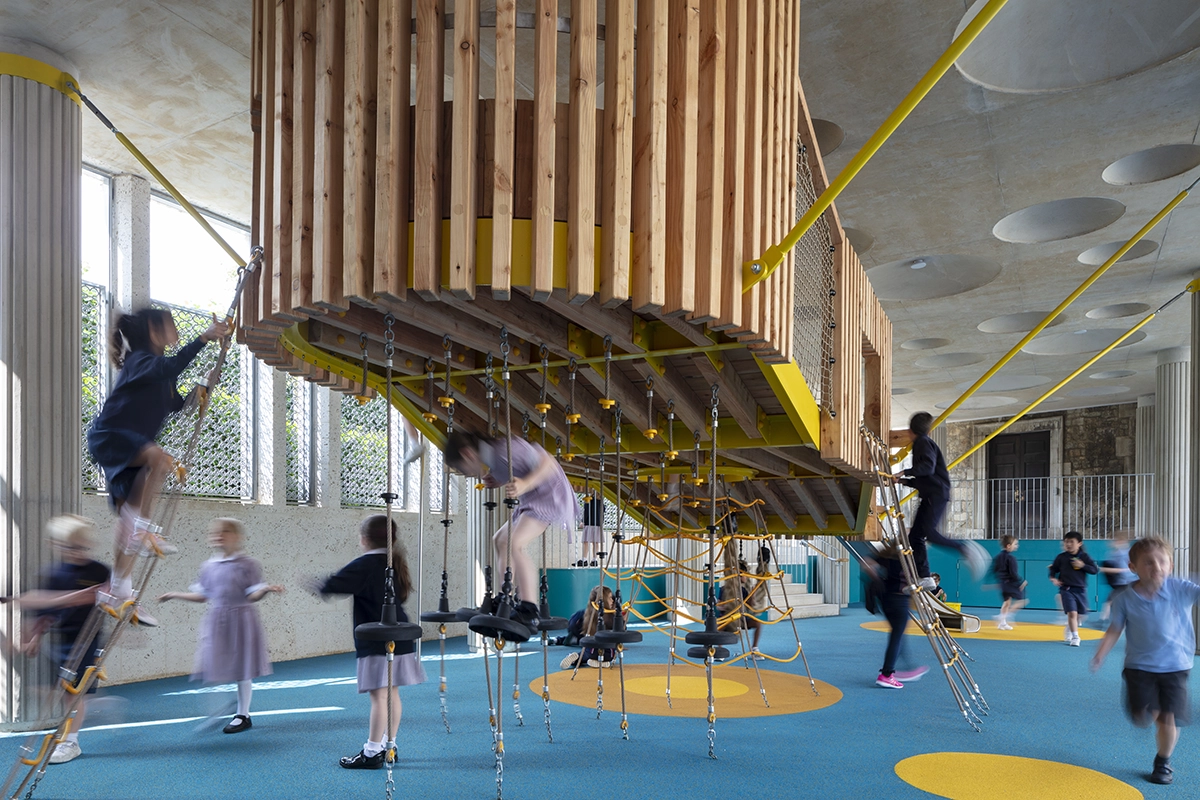The school playground is more than just a place for children to run around and let off steam; it’s a dynamic learning environment that plays a crucial role in a child’s development. A well-designed school playground can foster physical activity, social interaction, creativity, and cognitive development. Some might argue that the playground is where pupils put what they’ve learnt in the classroom into action. Skills such as decision making, problem solving and social skills are just as important as maths, English and science. More often than not, small items and additions are made when small pots money become availible. We believe masterplanning the space and implementing portions when possible leads to a far more cohesive playground. In this blog post, we’ll explore the key elements and principals involved in designing the perfect school playground, with a focus on creating a space that enhances both education and recreation.
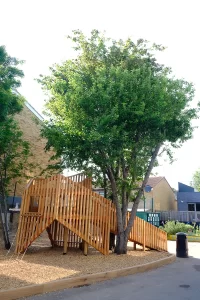
Understand the Purpose
Before diving into the design process, it’s essential to understand the purpose of the school playground. A successful playground should:
- Promote physical activity: Encourage students to be active and engage in physical exercise, helping to combat childhood obesity and improve overall health.
- Support social interaction: Create opportunities for children to interact, develop social skills, and build friendships.
- Stimulate creativity and imagination: Provide a space where children can explore, create, and let their imaginations soar.
- Enhance learning: Incorporate elements that facilitate educational activities, both structured and unstructured.
- Ensure safety: Prioritise safety in all aspects of the playground design to minimise risks and accidents.
Involve the Community
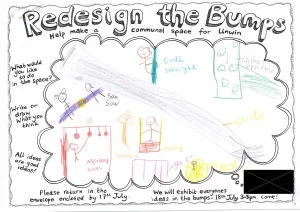 Designing a school playground is not a one-person job. Involving the school community, including specialist designers, independent play inspector, students, parents, teachers, and administrators, can lead to a more inclusive and successful design. Conduct surveys, hold meetings, and gather input to ensure that the playground meets the needs and preferences of everyone involved.
Designing a school playground is not a one-person job. Involving the school community, including specialist designers, independent play inspector, students, parents, teachers, and administrators, can lead to a more inclusive and successful design. Conduct surveys, hold meetings, and gather input to ensure that the playground meets the needs and preferences of everyone involved.
For some useful tips on how consultations can be done, see our blog post here
Assess the Space
Every school has a unique layout and available space for a playground. Begin the design process by assessing the available space and its limitations. Take into consideration factors like existing structures, topography, drainage, underground services, and safety zones. This assessment will help you make the most of the space while adhering to safety regulations.
Create Zones and Divisions
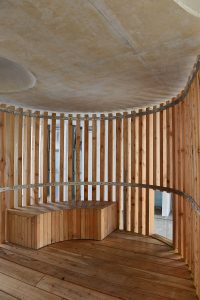 A well-organised playground should have different zones or divisions to cater to various age groups and activities. Consider dividing the playground into areas for younger children, older children, and potentially separate areas for specific activities such as sports, art, reading, physical play, or gardening. This division helps prevent conflicts and ensures that each group has access to age-appropriate equipment and activities.
A well-organised playground should have different zones or divisions to cater to various age groups and activities. Consider dividing the playground into areas for younger children, older children, and potentially separate areas for specific activities such as sports, art, reading, physical play, or gardening. This division helps prevent conflicts and ensures that each group has access to age-appropriate equipment and activities.
Prioritise Safety
Safety should always be the top priority when designing school playgrounds. Implement safety measures such as soft landing playground surfaces under play equipment to reduce the risk of injuries from falls. Choose age-appropriate equipment and inspect it regularly for maintenance and potential hazards. If the design is created by a specialist, assure that they work alongside and independent play inspection company to get a detailed risk report. These reports should be done during the design, pre completion on site and post completion. Additionally, consider proper fencing and gating to control access and prevent unauthorised entry.
Balance Nature and Play
Incorporating elements of nature into the playground can offer numerous benefits. Trees, shrubs, flowers, bug hotels, ponds and natural landscapes can provide shade, stimulate the senses, and create a calming atmosphere. Balance these natural elements with play equipment to encourage children to learn about, explore, and connect with the environment. A playground is also a great opportunity to improve local biodiversity.
Choose Playground Equipment Wisely
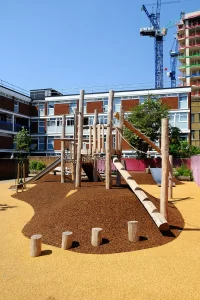 Selecting the right playground equipment is a critical aspect of playground design. Keep the following considerations in mind:
Selecting the right playground equipment is a critical aspect of playground design. Keep the following considerations in mind:
- Age-appropriate: Ensure that the equipment is suitable for the age group using it to prevent accidents and promote engagement.
- Inclusive design: Select playground equipment that accommodates children with diverse abilities, promoting inclusivity.
- Variety: Include a range of playground equipment, such as swings, slides, climbing structures, and interactive elements like sand or water play. Each item of playground equipment exercises different parts of the body and mind.
- Durability: Choose high-quality, durable materials that can withstand heavy use and various weather conditions.
- Accessibility: Make sure the playground is accessible to children with disabilities, incorporating ramps and adaptive equipment as needed.
Incorporate Educational Elements
A school playground can serve as an extension of the classroom, offering opportunities for learning through play. Consider including educational elements such as:
- Outdoor classrooms: Create designated spaces with seating and blackboards where students can draw and teachers can conduct lessons or group activities.
- Sensory gardens: Plant aromatic herbs, flowers, or textured plants to stimulate the senses and teach children about nature.
- Interactive science exhibits: Install interactive exhibits related to science, mathematics, or environmental studies to spark curiosity.
- Art installations: Foster creativity by incorporating art installations that encourage children to express themselves.
Promote Physical Fitness
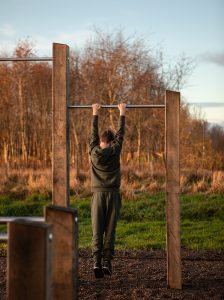 Encourage physical fitness by incorporating elements that challenge children’s physical abilities. This can include:
Encourage physical fitness by incorporating elements that challenge children’s physical abilities. This can include:
- Climbing structures: Install climbing walls, ropes, or nets to help develop strength, coordination, and problem-solving skills.
- Sports courts: Create dedicated spaces for sports like basketball, football or tennis to promote physical activity and team play.
- Running tracks: Design tracks or pathways that encourage running, jogging, or even cycling to promote cardiovascular fitness.
Monkey bars for example are a fantastic and fun way to exercise the upper body and improve grip strength. The effect of strengthening in this way goes on to improve posture, giving better attainment during class. Check out our blog post here for more information on this.
Sports aren’t for everyone. A well designed playground can really motivate individuals that aren’t so into sport to be more active. They may help pupils to discover new skills such as climbing and gymnastics.
Foster Social Interaction
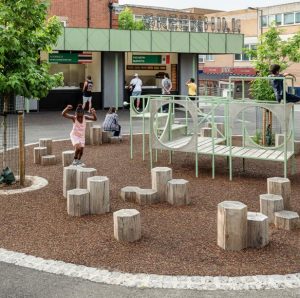 The school playground is a social hub where children develop vital social skills. Design features that promote interaction and cooperation, such as:
The school playground is a social hub where children develop vital social skills. Design features that promote interaction and cooperation, such as:
- Seating areas: Install benches, picnic tables, or amphitheatres where students can gather, eat lunch, or engage in group discussions.
- Multi-user equipment: Include equipment that requires teamwork, like seesaws, cooperative games, or group swings.
- Quiet spaces: Create cosy nooks or reading corners where children can engage in quieter activities or conversations.
Conclusion
Designing a school playground is a complex but rewarding endeavour. By considering the purpose, involving the community, prioritising safety, and incorporating elements that promote physical activity, learning, and social interaction, you can create a vibrant and inclusive space that enhances the educational experience of every child who steps onto the playground. A well-designed school playground isn’t just a place for play; it’s a place for growth, development, and lasting memories.
